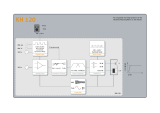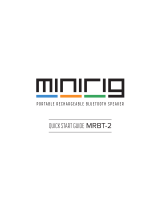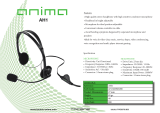
MixPre User Guide
15
Channel Screen - Advanced Mode
The MixPre’s exibility is enhanced by its ability to select various input
types to its mixer channels. On the MixPre-3, channels can be sourced
from XLR mic/line input, 3.5 mm Aux line or mic input, or from USB
channels. On the MixPre-6 and MixPre-10T , channels can be sourced
from XLR or TRS mic/line input, 3.5 mm Aux line or mic input, or from
USB channels.
Access the channel’s input settings by pushing in the channel’s knob.
There are three channel inputs on the MixPre-3 , 6 channel inputs on
the MixPre-6, and 10 channel inputs on the MixPre-10T .
Channels 5 and 6 on MixPre-6 and 9 and 10 on the MixPre-10T are
controlled in the Inputs menu. Input source, solo, mute, arm, gain,
pan, low cut, and linking are all available in this menu.
Channels use a dual gain stage. Adjust the gain control in the Channel
Screen and fader level with the knob. Limiters are present on each
channel and the LR mix bus and will ensure that your audio is safe
from accidental clipping.
SOLO Lets you “solo” the selected channel in the headphone output.
Solo mode can be set to “Individual” or “Multiple” in the HP menu.
When a channel is soloed, the LED ring will ash orange.
MUTE Provides quick access to muting an input.
ARM Allows pre-fade recording of the channel to an individual track
on the SD card.
GAIN Sets the sensitivity of the input. Generally, the Gain should be
set so that the loudest parts of the audio signal just touch the red
segments of the meters. The control knobs on the front panel act as
faders.
PAN Lets you position the audio of the channel anywhere between
Left and Right in the stereo image of the LR mix and Stereo Out.
LOW CUT Turn Low Cut lter on or off. Useful for reducing unwanted
low frequency in the audio of the select channel. Frequency is adjust-
able from 40, 80, 120, or 160 Hz.
INPUT Select one of the available Mic, Line, Aux (available when Aux
In Mode is Mic or Line) or USB inputs as the channel source.
PHANTOM Turn on 48 V phantom power when using a condenser
microphone in the selected channel (available when Input is Mic)
PHASE Phase inversion (or polarity reversal) is used to compensate
for incorrectly wired, balanced cables, to prevent signal cancellation
when a source is dual-mic’d from opposite directions, or to reverse
left/right with microphones in a mid-side (MS) conguration.
DELAY Input delay may be used to compensate for ‘phasey’ sounding
audio because of time-of-arrival differences between sound sources,
such as a boom mic and wireless radio mic picking up the same
sound source.
LINKING All MixPre’s can link channels 1 and 2 either as a stereo
pair, mid side pair, or turn linking off.
MIXPRE-3 BASIC MODE FEATURES AND MENUS
Screen Sub-menu Available Options and Functions
File List File Options The File List is where you manage upcoming and previously recorded les’ metadata and cue
markers. Available options:
Name - Names the le and scene metadata.
Number - Three digit number that follows the Name entry for the le name. Number resets to 001
when the Name is changed. Number is also stored in the take metadata eld.
Trash File - Sends the select le to the Trash folder.
Cue List - Enters the Cue List where
Menu Presets Save and load user presets to and from SD card and internal memory or reset unit to factory default
settings.
Menu Project Create New Projects
Open Projects
Copy Project from SD card to USB drive.
Trash existing projects.
Menu Inputs Aux In Mode sets the source for the 3.5 mm Aux/Mic In. Select from Mic, Line, Timecode, or Off.
Menu Timecode Timecode Mode (Free Run, Time of Day, Record Run, Aux In 1, Aux In 2, HDMI TC In, Off)
Frame Rate (23.98, 24, 25, 29.97 ND, 29.97 DF, 30, 30 DF
Jam - Jams the timecode generator from sources Aux 1 or Aux 2
Set TC -Sets the Timecode value for Free Run or Rec Run modes set Hour, Minutes, Seconds,
Frames
Set UBits - Sets the User Bit format and value (Custom User, Month/Day/User, Day/Month/User,
External)
Menu Tone Turn the test tone on or off. Test tone is a 1kHz sine wave at -20dBFS.
Menu Record Pre-roll (1-10 seconds)
Record Trigger (Off, HDMI ag, or Timecode)
Record Bells (On or Off)
Menu SD Card Displays SD card info, allows formatting the SD card, and emptying their trash folder.
Menu USB Drive Displays USB drive info and allows formatting of the USB drive.
Menu Date/Time Sets current date/time and format.
Menu System Mode - Select your mode of operation from Basic, Advanced, or Custom
Custom Mode - Available when in Custom Mode. Select functions to be Basic or Advanced (Channel,
Gain, Headphone, Record, Metadata, Outputs)
USB-C - Sets the functionality of the USB-C connector from Audio (and power) or Power Only
USB Audio - sets the content of the USB audio inputs and outputs (Normal = advertises all USB
channels to computer or Stereo Out = Left and Right mix only advertised to computer)
File Transfer - Enters le transfer mode so that you can transfer les from the SD card to a computer.
Bluetooth
®
- turn the Bluetooth circuitry on or off.
Wingman App password -Setup a password to prevent other mobile devices from connecting to
MixPre over Bluetooth.
LCD/LED brightness setup
System date and time setup
Updating Firmware
Version
Regulatory information
Plugins - Displays installed Plugins and applies Plugins, such as the Musicians plugin.
Menu Power Select the type of batteries being used (Alkaline, NiMH, L-Mount) to ensure that the Power Status
icon on the Home screen accurately displays remaining battery level.
Menu HP Preset Select either LR Stereo or USB 1,2 as the headphone sources.
Channel Pan
Channel Input
Channel Phantom
Channel Low Cut
3
MIXPRE-3 ADVANCED MODE FEATURES AND MENUS
Screen Sub-menu DeScription
Home File List The File List is where you manage upcoming and previously recorded les’ metadata and cue
markers. Available options:
Undo - Sends the last recorded le to the Undo folder and rolls back the Number to the previous
value.
Name - Names the le and scene metadata.
Number - Three digit number that follows the Name entry for the le name. Number resets to 001
when the Name is changed. Number is also stored in the take metadata eld.
Notes - Enter or edit notes that are stored in the le’s metadata.
Track Names - Enter or edit names for all record tracks.
Rename - Renames the le.
Trash File - Sends the select le to the Trash folder.
Cue List - Enters the Cue List where
Re-Record LR - This function requires Iso track recording and Remix to be on. Allows you to rerecord
the LR mix track.
Menu Presets Save and load user presets to and from SD card and internal memory or reset unit to factory default
settings.
Input Types Description
Mic Use for microphones. For condenser mics
requiring 48 V phantom power, set Phantom
to On.
Line Use this type for balanced analog line level
sources.
Aux In 1-2 Use for unbalanced stereo input.
USB Use for sources coming from a computer via
USB-C.






















